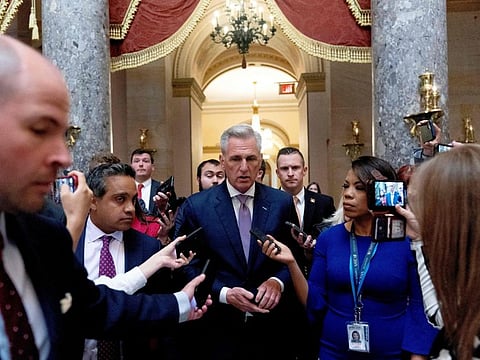McCarthy proposes $1.5 trillion debt-limit increase
The plan would also rescind unspent Covid-19 funds

Washington: US Speaker Kevin McCarthy proposed a bill that would raise the US debt limit for about a year and cut federal spending, ahead of a planned House vote on the Republican proposal next week.
The 320-page plan would increase the debt ceiling by $1.5 trillion, enough to stave off a US payments default until March 31, 2024 at the latest. It also contains a host of conservative proposals that are non-starters with congressional Democrats and the White House.
The speaker hopes that, if the House can pass the proposal, President Joe Biden will then engage in talks to resolve the ongoing stalemate over raising the $31.4 trillion debt limit. Without an increase or suspension of the ceiling, the US would default on payment obligations as soon as June “- an event Treasury Secretary Janet Yellen has warned would cause economic and financial “collapse.”
The McCarthy plan would bring discretionary spending back to 2022 levels “- a $130 billion cut. Future increases would be capped at a 1 per cent annual rate for the following decade.
The reductions “are not draconian, they are responsible,” McCarthy said. “If Washington wants to spend more it will have to come together and find savings elsewhere just like every single household in America.”
The plan would also rescind unspent Covid-19 funds, impose tougher work requirements for anti-poverty benefits, ease regulations on energy projects and end some tax breaks for clean-energy projects including electric vehicles.
McCarthy’s bill would require food stamp recipients between the ages of 19 and 56, except those with dependents, to work at least 80 hours per month, and limit waivers. That would rope in more individuals than the current age limit of 50. The work requirement would also apply to Medicaid beneficiaries, something that could see uninsured health costs shifted onto hospitals.
Clean Energy
In a last-minute concession to the conservative House Freedom Caucus, the bill would end hundreds of billions of dollars in tax breaks for clean-energy projects and the purchase of qualifying electric vehicles. It would also end an $80 billion funding boost to the Internal Revenue Service that’s designed to boost audits of the wealthy.
Those features target elements of Biden’s Inflation Reduction Act, which passed last year. But the GOP plan doesn’t repeal popular drug price cuts - sparing House moderates a painful vote.
What is on the cutting block, however: Biden’s student debt relief plan. McCarthy also said the legislation would put limits on the executive branch’s regulatory power more broadly.
The top Democrat on the Energy and Commerce Committee, Representative Frank Pallone, called the plan “a Trojan Horse intended to use red tape and onerous paperwork to kick millions of people off their health insurance because Republicans do not believe in our nation’s social safety net.”
Biden has released his own $7 trillion budget proposal that would reduce deficits by $3 trillion over a decade compared with current law - mostly through tax increases. Biden has demanded the GOP produce its own 10-year plan and admit that it wants to cut spending in order to pay for an extension of trillion of dollars in tax cuts enacted by former President Donald Trump.
The fractious GOP conference has been unable to agree on such a budget proposal, however, and has instead focused on formulating the debt-ceiling bill with the deadline for a default looming. The bill is sponsored by Budget Chairman Jodey Arrington, who had earlier been sidelined by McCarthy.
Analysts at Goldman Sachs Group Inc. on Tuesday warned that, due to declining tax receipts, the date for a US default could be closer to June “- rather than August, as some economists have predicted. The Treasury Department is expected soon to offer an update on the timeline for when it will exhaust special measures to keep within the current, $31.4 trillion debt ceiling and avoid a default.
Sign up for the Daily Briefing
Get the latest news and updates straight to your inbox



